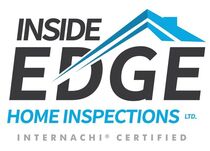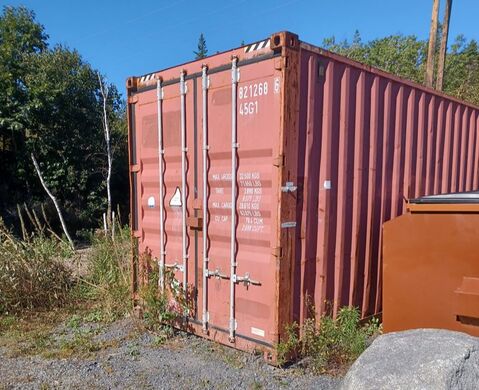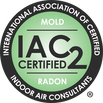Mike's Home Inspector BlogMichael Burfitt |
|
At this time of this writing in the fall of 2022, housing prices are beginning to fall in Halifax. That is of course good news but the simple fact is that, when factoring in higher interest rates, housing remains unaffordable for far too many people in Nova Scotia. Rightfully, some people are looking for alternatives to the sky-high cost of housing and one such up-and-coming trend is that of shipping container homes. Sounds like a great way to build a home at a great price, right? Not so fast! It certainly sounds appealing: a disused shipping container can be purchased for only a few thousand dollars and is constructed mainly of solid steel. They have literally been around the world multiple times in all weather conditions and are built to last. This however does not mean they necessarily translate to a solution to the housing crisis. What’s Wrong with Shipping Container Homes?
The biggest issue is that they are small. They are a decent height for those not over 6’6” (like almost everyone but me) at 8.5 feet and are plenty long (usually 40 feet) but are a mere 8 feet in length. That doesn’t sound terrible until you consider that…. Homes Need Utilities! A home is a complex system of interdependent components: electrical, plumbing (both supply & waste) and heating, ventilation & air conditioning (HVAC) pipes that run behind the walls in all homes (and are required by all building codes)! This means that a significant portion of the interior space needs to be dedicated to these items, further reducing the living space. Speaking of HVAC…... Metal is a Conductor of Heat AND Cold When I was a teenager, I occasionally helped load shipping containers that were bound for various projects in Northern Africa. On one hot day, we measured 52 degrees Celsius inside the container! It was like being in an oven and while I wasn’t loading anything that day, I tried to see how long I could last. It was less than a minute before I started sweating uncontrollably and I had to leave. Metal is a conductor both of heat and cold and we certainly get both extremes in Nova Scotia. Neither air conditioning nor high R insulation are required in our province, but I don’t see how one can survive without them in a shipping container. That’s not even getting into…. Shipping Containers are (Not) Really Strong Shipping containers are strong and heavy, right? Think about it: they are stacked 9 high on ships and face countless treacherous weather conditions in the open sea. However, unlike goods, people need air! (windows & doors). You might think that it’s as simple as cutting a few holes in the steel, but the fact is that these containers are designed to transfer all the weight to the ends, so cutting a hole for a window requires structural reinforcement. Furthermore, many Engineers, Architects and Contractors refuse to work with shipping containers as they are not familiar with them (and that goes for home inspectors too!) and consider them too high a liability to work on. An Important Disclaimer I am NOT in any way an expert on construction of shipping container homes and there are some advantages that I did not touch on. As well, you may be reading this in the future and this type of construction might go mainstream with improvements in construction techniques. I am just pointing out that in 2022, the cost savings can be quickly wiped out with all the expensive modifications required to make containers habitable. I am in favor of anything that can make housing affordable to everyone on the planet but while on the surface this seems like the ideal solution there are too many disadvantages to this type of construction to consider it a viable option at this time. There are few things I prioritize over quality home inspections and my family is at the top of that list. Like all parents I always try to keep my child safe and healthy but, like being a great home inspector, there are always lessons to be learned and improvements to be made.
A few years ago my son was born, and I officially became a parent. I remember on the drive home from the hospital thinking about how it was crazy that possibly the two biggest life changers most people face (moving into a new house and bringing home a newborn) both have no technical manuals and while I knew I would be a great parent, I had the all-too-common feeling of not even knowing where to start. But enough about my personal ramblings: this article is about providing a safe and healthy environment for our little ones. I have learned a lot, both through my home inspector training and general life experience about having a safe and healthy home. New parents already know about baby gates, outlet covers, etc. so I’m going to look at less obvious ways to keep kids healthy and happy. Houses (and Children) Need to Breathe! I just finished writing a post about mechanical ventilation before this. The obvious retort that I didn’t address in that post was “is ventilation REALLY that important? I grew up in an airtight home and did fine!” Most of the kids in my neighbourhood in my early 80s constructed subdivision were fine in terms of surviving but health problems such as asthma and ear infections were rampant. While I am no medical professional, I now realize the most likely reason for this was simple: the air was stale and contaminants floated in the air, especially cigarette smoke. Yes, for you younger readers, back in the 80s people smoked EVERYWHERE except in schools and the concern for homebuilders was keeping heat in, not getting pollutants out. Lead is Still an Issue Today I remember as an 80s kid pulling up to the gas station and hearing my parents ask for “regular unleaded”. Lead was slowly removed in the 1980 and by the time the 90s arrived the gas station no longer had leaded gasoline. So, it’s great that lead is no longer used, and we don't need to worry, right? WRONG! Fact is, lead is still used to this day although usually either in very small quantities or safely sealed, such as in lead-acid batteries. Lead poisoning has been linked to a number of significant neurological issues and it affects children much more than adults. What's worse is that lead has a sweet texture, which can be attractive to exploring babies and toddlers. There is certainly no need to panic about lead, just to be aware. Some common areas that lead is found are: Water Pipes In the Halifax area, they are ONLY found in Peninsular Halifax, Dartmouth inside Highway 111 and near Chocolate Lake and even within these areas, only a small fraction of homes use lead rather than copper supply lines. Any home inspector or plumber can usually quickly tell you if you have lead pipes and point you to the next steps to safely remove them. Keep in mind that lead solder was used until 1986 and lead was permitted in plumbing fixtures (in small quantities) until 2014! Paint This varies: before 1950 paint had a large amount of lead, by 1980 lead levels were greatly reduced, by 1992 paint is virtually lead free. While on the wall it isn’t too hazardous (almost all pre-90s houses have had leaded paint covered over by another lead-free layer), stripping or disturbing lead paint can spread toxic lead dust throughout a home. Mini-Blinds. While they were voluntary recalled in 1996, some of these window coverings may still be around. Even if kept out of reach of children, the Sun’s UV rays slowly degrade the blinds and releases lead dust into the air. These should be removed and replaced immediately if discovered. Carbon Monoxide (CO) is a Silent Killer Any home that uses a heat source other than electricity and/or has an attached garage has carbon monoxide as a result of the combustion process. Usually, it is safely vented outside but no system is perfect. I have heard some people claim it’s not big deal since you can smell it and this is wrong. CO, like Propane and Natural Gas is 100% odourless, colourless and flavourless. The difference is that companies add Methanethiol, commonly known as Rotten Egg smell that is easily detected by humans, while CO obviously has no additives and cannot be detected by any human senses. Children are especially vulnerable to CO poisoning, especially after bedtime and sadly far too many adults and children pass away in their sleep due to CO. Therefore, it is imperative to not only have working CO detectors but to regularly inspect and replace if necessary. These are just a few of many examples that new parents, often already overwhelmed, simply don’t consider when childproofing their home for the first time. |
Archives
July 2024
Categories
All
|
|
Inside Edge Home Inspections Ltd.
Halifax, NS 902-209-9921 [email protected] Proudly Serving the HRM & Central Nova Scotia |



 RSS Feed
RSS Feed

